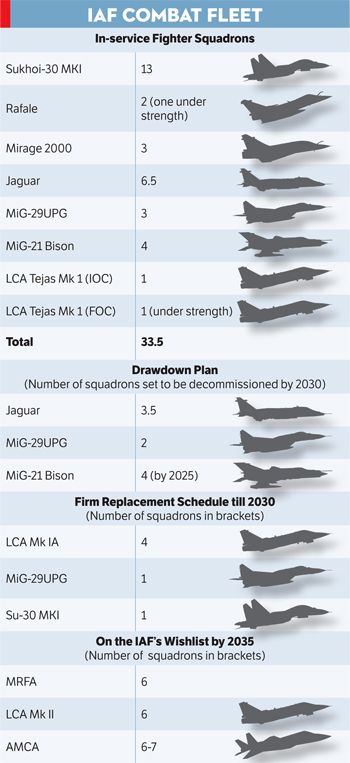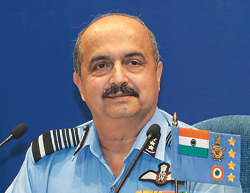INDIAN ARMED FORCES CHIEFS ON
OUR RELENTLESS AND FOCUSED PUBLISHING EFFORTS

SP Guide Publications puts forth a well compiled articulation of issues, pursuits and accomplishments of the Indian Army, over the years

I am confident that SP Guide Publications would continue to inform, inspire and influence.

My compliments to SP Guide Publications for informative and credible reportage on contemporary aerospace issues over the past six decades.
Future Shock!
The Indian Air Force is banking heavily on ‘Make in India’ to bail it out of an existential crisis as half of its fighter fleet nears the end of its life this decade

The cumulative delay over replacement of a diverse legacy fleet of fighter aircraft now threatens to force the world’s fourth largest air force on the horns of uncertainty imposed by a high stakes transformation roadmap which puts the traditionally non-performing domestic defence industrial complex at the heart of the plan.
About half of the current IAF’s squadron strength of 33.5 combat units will be due for replacement over the next decade, and it is banking heavily on ‘Make in India’ to bail it out.
“We will not be able to equip (the IAF) with 42 squadrons in the next 10-15 years. Our numbers will stay about 35 squadrons. At the moment, there’s no hope of the squadron strength going up beyond this number”
—Air Chief Marshal V.R. Chaudhari
The newly-appointed Chief of the IAF, Air Chief Marshal Vivek Ram Chaudhari has already brought down the asking from 42 authorised fighter squadrons to 35. “We will not be able to equip (the IAF) with 42 squadrons in the next 10-15 years....Our numbers will stay about 35 squadrons. For now, there’s little hope of the squadron strength going up beyond this number,” he declared publicly with striking candour.
The MiG-21 Bison, and the legacy medium fighters the Jaguar, MiG-29 and Mirage 2000 which have been the backbone of the IAF for decades are all due for phase-out by 2032. The MiG-21 Bison is already operating beyond its intended life, with the drawdown plan for its last four squadrons having been extended by four years beyond 2021 in a desperate bid to make up for the shortfall in numbers.

While doing some candid loud thinking about the blueprint of the fighter fleet over the next 10-15 years, Air Chief Marshal Chaudhari listed out “four squadrons of the Light Combat Aircraft (LCA) Tejas Mk 1A, 6-7 squadrons of the Advanced Medium Combat Aircraft (AMCA -India’s indigenous fifth generation fighter which is as yet on the drawing board) and six squadrons of the Multi-Role Fighter Aircraft (MRFA)” as the likely additions over this time frame.
In addition, the acquisition of one additional squadron each of the Su-30 MKI (12 aircraft, replacements for losses in accidents, to be serial produced by HAL, Nasik) and MiG-29 (21 mothballed aircraft to be upgraded and imported from Russia) have already been approved. The IAF would expect delivery by 2025. An order for four squadrons LCA Mk IA (83 aircraft) has already been placed with HAL and deliveries are scheduled to commence from 2024.
It is not clear whether the omission of the LCA Mk II was deliberate or an oversight by the Air Chief during his remarks to the media ahead of the 89th Air Force Day. Yet on the drawing board, the LCA Mk II has been offered by India’s Aeronautical Development Agency (ADA) as a more contemporary and capable variant of India’s indigenous fighter. Several earlier published accounts have mentioned six squadrons of the LCA Mk II as part of the IAF’s fleet composition in the next decade. While Air Chief Marshal Chaudhari repeatedly emphasised IAF’s “commitment to AMCA”, he was silent on the LCA Mk II. The Indian Defence R&D and Industrial establishment is thought to be working on the LCA Mk II and AMCA in parallel.
Responses to an RFI to global aerospace majors for acquiring 114 MRFA under the Make in India Strategic Partnership Model are being processed “to mitigate the gap” in numbers.
DRAWDOWN & THE ROAD AHEAD
Besides the four residual squadrons of the MiG-21 Bison which will be decommissioned no later than 2025, at least 3.5 Jaguar squadrons and two MiG-29UPG will need to be retired by 2030, although the entire lot of 6.5 squadrons of Jaguars, three MiG-29UPG and three Mirage 2000 squadrons will be approaching the end of their service lives.
So, it is clear that if the IAF is to stall a freefall in squadron strength, the LCA Mk II production line must kick off this decade in parallel to that of the MRFA’s. Air Chief Marshal Chaudhari also spoke of the “aggressive timelines” for the AMCA. He expressed the hope that induction of the AMCA would “begin early in the next decade”.
The AMCA is meant to be the mainstay of the IAF in the decades ahead. For this, it is essential that India’s Defence R&D establishment and Industrial Complex reverse the history of delay and failure to deliver on time. The stakes are very high and there is meant to be no fallback.
Traditionally, additional squadrons of the Su-30s have been ordered as a hedge, whenever the IAF has been pressed for numbers. The Defence establishment has predictably leaned on the Su-30 option under pressure, as it did in 2006, when the then IAF Chief, Air Chief Marshal S.P. Tyagi rang the alarm bells, warning the establishment through a letter to the then Defence Minister Pranab Mukherjee that the IAF’s squadron strength was set to fall below that of even the Pakistan Air Force’s.
The wager is out on whether history will be repeated or India’s Defence Industrial complex will finally redeem itself.






